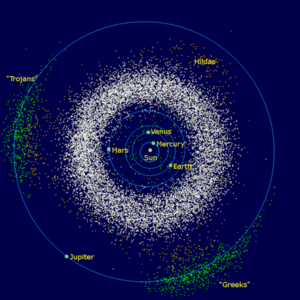Asteroid Belt
The Asteroid Belt is the circumstellar disc in the Solar System located roughly between the orbits of the planets Mars and Jupiter. It is occupied by numerous irregularly shaped bodies called asteroids or minor planets. The asteroid belt is also termed the main asteroid belt or main belt to distinguish it from other asteroid populations in the Solar System such as near-Earth asteroids and trojan asteroids. About half the mass of the belt is contained in the four largest asteroids: Ceres, Vesta, Pallas, and Hygiea. The total mass of the asteroid belt is approximately 4% that of the Moon, or 22% that of Pluto, and roughly twice that of Pluto's moon Charon (whose diameter is 1200 km).

Ceres, the asteroid belt's only dwarf planet, is about 950 km in diameter, whereas Vesta, Pallas, and Hygiea have mean diameters of less than 600 km. The remaining bodies range down to the size of a dust particle. The asteroid material is so thinly distributed that numerous unmanned spacecraft have traversed it without incident. Nonetheless, collisions between large asteroids do occur, and these can form an asteroid family whose members have similar orbital characteristics and compositions. Individual asteroids within the asteroid belt are categorized by their spectra, with most falling into three basic groups: carbonaceous (C-type), silicate (S-type), and metal-rich (M-type).
The asteroid belt formed from the primordial solar nebula as a group of planetesimals. Planetesimals are the smaller precursors of the protoplanets. Between Mars and Jupiter, however, gravitational perturbations from Jupiter imbued the protoplanets with too much orbital energy for them to accrete into a planet. Collisions became too violent, and instead of fusing together, the planetesimals and most of the protoplanets shattered. Some fragments eventually found their way into the inner Solar System, leading to meteorite impacts with the inner planets. Asteroid orbits continue to be appreciably perturbed whenever their period of revolution about the Sun forms an orbital resonance with Jupiter. At these orbital distances, a Kirkwood gap occurs as they are swept into other orbits.
Classes of small Solar System bodies in other regions are the near-Earth objects, the centaurs, the Kuiper belt objects, the scattered disc objects, the sednoids, and the Oort cloud objects.
On 22 January 2014, ESA scientists reported the detection, for the first definitive time, of water vapor on Ceres, the largest object in the asteroid belt. The detection was made by using the far-infrared abilities of the Herschel Space Observatory. The finding was unexpected because comets, not asteroids, are typically considered to "sprout jets and plumes". According to one of the scientists, "The lines are becoming more and more blurred between comets and asteroids. [1]
Maldek Explosion
The 5D planet Tara exploded millions of years ago and as a result, was sucked into a reversal black hole which fragmented the entire fifth dimensional planetary blueprint into 12 planetary bodies in our current third dimensional Solar System. These 12 planets are Mercury, Venus, Earth, Mars, Maldek, Jupiter, Saturn, Uranus, Neptune, Pluto, Nibiru and then the Sun star. Current science recognizes only eight planets of the twelve in our Solar System, along with dwarf planets. The planet Maldek is the counterpart of the bodily remnants of Tiamat in the 3D Universe of which the asteroid belt exists between Mars and Jupiter. This means that the Asteroid Belt we see in the 3D Universe is Maldek's exploded planet, and the asteroid belt in the 5D Universe is Tiamat's exploded planetary body.